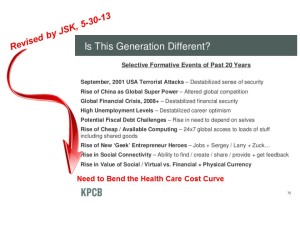 Tablets, wearables, smartphones, video and QR codes: these are fast-growing platforms moving data around the global economy. They’re also fast=growing platforms for health care where we live, work, play and pray.
Tablets, wearables, smartphones, video and QR codes: these are fast-growing platforms moving data around the global economy. They’re also fast=growing platforms for health care where we live, work, play and pray.
Mary Meeker’s annual presentation on Internet Trends at the D11 Conference, is fresh off the virtual press in its shiny new 2013 version. Meeker has been with the investment firm Kleiner Perkins Caulfield Byers (KPCB) since 2011, and was with Morgan Stanley from 1991 to 2010. She’s a veteran who’s watched the Internet basically from The Beginning.
Of the 117 slides in her informative, gargantuan deck (a Meeker hallmark every year), at least 10 speak to some aspect of health; I’ve synthesized Meeker’s themes for health as follows:
- Video, where Big Brother meets Big Mother (THINK: remote health monitoring and safe aging at home)
- Social sharing for, say, health and wellness (where Jawbone UP meets Yelp!)
- The growth of fitness wearable devices
- Changing health behaviors for impacting premature death (which I addressed here on Health Populi)
- The advent of sensor-enabled wearable computing to emerge in 2014
- QR code scanning for nutrition and other applications
- The publication of TIME’s Bitter Pill story, covered here in Health Populi
- The growth of Medicare and health care and other spending that will overtake economic growth sooner rather than later.
For the mobile health lens on Meeker’s views, see Brian Dolan’s take in MobiHealthNews here.
Health Populi’s Hot Points: Consumers’ growing adoption of Meeker’s many platforms, from phones to tablets to social networking and wearable sensors, will enable daily quantification of a variety of activities, from food tracking and safe and consistent drug dosing to social networking to bolster healthy choices. Consumers’ taking on the role of more self-care is a form of self-service vertical industries outside of health care are taking advantage of: consider self-checkout at the supermarket, photo development online via Shutterfly, stock-trading on Vanguard.com, and online bill paying.
Pushing these functions out to consumers helps lower transaction costs for companies serving these market segments: grocers, photography services, financial services, and retailers.
Will healthcare self-service by health-engaged consumers lower costs for providers?
The right context for that question is value-based health care and risk-management, where a growing proportion of doctors and hospitals are taking on financial risk for population health management. The more consumers can do for themselves in remote monitoring, on-time efficacious self-care, and safe aging at home, the more providers can manage their financial risk for that patient’s condition(s).
As Judith Hibbard pointed out in the February 2013 issue of Health Affairs, greater patient activation can result in lower costs for a health plan.




 Thanks to Feedspot for naming this blog, Health Populi, as a
Thanks to Feedspot for naming this blog, Health Populi, as a